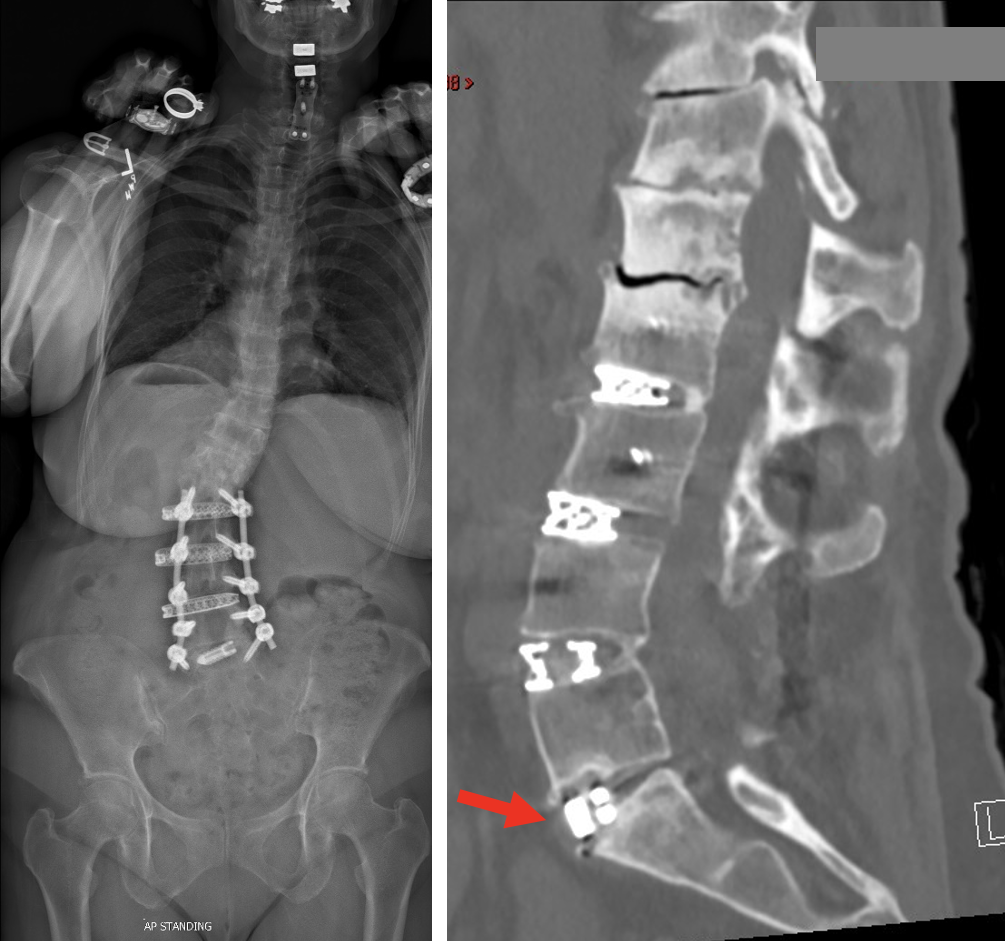
Patient referred with scoliosis above previous instrumentation and failure to heal (fuse) at the prior TLIF at the L5-S1 level (red arrow)

As part of revision surgery, patient had ALIF at L5-S1 with personalized cage to fit the space (green arrow)
What is Anterior Lumbar Interbody Fusion?
Anterior lumbar interbody fusion, or ALIF, is just like any spinal fusion procedure used to correct those painful, life-inhibiting problems in the lumbar (lower back) region of the spine, except this it is performed from the front instead of the back of the patient.
Who is ALIF for?
Patients who undergo ALIF typically have one of the following problems:
- Severe lower back or leg pain that non-surgical treatment cannot sufficiently address
- Pain caused by degenerative disc disorder in the lumbar region
- Spondylolisthesis (vertebra slips forward onto the bone below it)
- Scoliosis (sideways curvature of the spine)
- Spinal fractures
- Spinal instability
ALIF may be recommended as a treatment option only after the surgeon completes a number of assessments including the patient’s spinal condition, age, activity levels, medical history, etc. Talk to your surgeon or contact us to set up an appointment to see if ALIF is right for you.
How is the ALIF procedure performed?
First, the patient lies on their back and undergoes general anesthesia. Once the patient is asleep the surgeon will make an incision in the abdomen and retract the muscles and various structures to gain vision and accessibility to the front of the vertebral body in the lower back region. The disc between the bones is removed, followed by fusion of the two adjacent vertebrae often with the use of a spacer/cage. A plate may be placed spanning the bones above and below the disc space for better support and stability during the healing process. Once that is completed, the structures and muscles are safely put back in their former place and the incision is stitched closed.
The success of this surgery is dependent on various factors including age, spinal condition, the patient’s overall health, and their activity level.
How long is recovery for those who undergo ALIF?
The recovery period can vary and depends on the body’s healing capacity. Your surgeon may also prescribe pain medications, a brace, and follow-up physical therapy upon discharge from the hospital.
Your rest period or inactivity depends on a few factors such as the type and extent of surgical procedure and the approach used to access your spine. Your return to work or normal activity depends on what work or activity you plan to perform. But generally, the initial healing time takes 3-6 weeks but the bony healing inside often continues for several months afterward.
We recommend that you strictly follow the post-operative instructions given to you by your surgeon to promote healing, reduce the possibility of post-op complications, and quickly get you back to doing the things you love in life.
What are the risks and complications of ALIF surgery?
Despite the advanced techniques and technologies available to surgeons, complications can still happen. Some of these include:
- Infection
- Nerve damage
- Blood clots or blood loss
- Bowel and bladder problems
- Adverse reactions to anesthesia
- Failure for the bones to heal together

